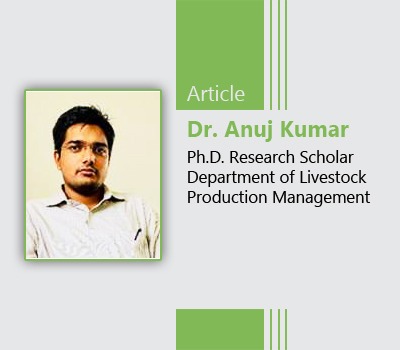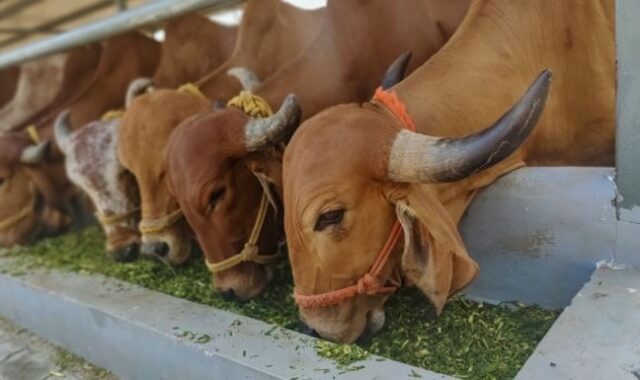The key to increasing dairy cattle productivity is the management. Dairy Cattle used to experience cold throughout the winter, which had a direct impact on their well-being and production. They need to be given extra care and attention at this critical period, including sufficient housing and nourishing feed to promote health. Dairy Cattles are more stressed in winter, which lowers their production. They go through certain physiological and behavioural changes during the winter. In particular in the Northern States of India, the significant metrological variance causes a drastic decrease in temperature even down to zero degrees during the months of December and January. It’s quite difficult to handle cattle during this winter, therefore it’s crucial to provide them proper care and management. Its better to prepare in advance to take appropriate steps to prepare and altered the sheds of dairy cattle to protect them from cold this will help the dairy farmers to prevent them from economic losses in the dairy farms.
Shelter management
To stop the wind from blowing directly onto the animals, curtains should be installed in the sheds of a loose housing arrangement. Materials like bamboo, dried grass, paddy straw, guinea bags, jute, tarpaulin etc. can be used to make curtains. Trees that are shaded by the shed should be trimmed to allow more sunshine to enter the house, which will not only heat it up but also disinfect the animal house due to the action of UV rays. Additionally, animals should be allowed to spend the day in open paddocks exposed to direct sunlight. Animal sheds shouldn’t have damp, chilly surfaces for extended periods of time. This might put animals, particularly young ones, at risk for a number of illnesses include pneumonia, fever, coccidiosis, diarrhoea, and even death in extreme circumstances. It’s better to provide sufficient bedding on a pucca (concrete) floor up to a depth of 4-6 inches for large animals and 2 inches for smaller animals as direct contact between an animal and a cold floor can cause increased body heat loss through conduction. As bedding material, dried grass, wheat straw, sawdust, paddy straw, rice husk, etc can be used. Blankets can be used on individual animals. However, the animal’s coat as well as the blanket material touching the animal’s coat must remain dry.

Ventilation
During the winter, proper ventilation must be maintained. For effective waste disposal and to ensure that ammonia gas does not build up too much in the shed, it should be cleaned at least twice per day. Regular cleaning of animals with a clean cloth or brush is advised. The animal itself tries to protect itself from the harsh cold as winter approaches by thickening its hair coat, using an insulating subcutaneous fat layer its body reserves, as well as by boosting its metabolism, respiration, heart rate, and blood flow. Animals’ hair should not be cut in the winter. Bathing of the dairy cattle should not be done with the cold water.
Feeding
During winter season should use a healthy, balanced feed for animals. The most widely available green fodder, berseem, has a high protein percentage and a high-water content, making it easy to maintain nursing and developing animals’ production levels. Therefore, for cost-effective manufacturing, protein-containing components such cakes in concentrates must be minimised. The order of the many cake kinds that can be employed is perhaps in the following order: mustard cake, cotton seed cake, groundnut cake, and soybean flakes. For feeding bigger animals when there is a lack of green fodder, 25–30 kg of legume-based fodder can be combined with 5–10 kg of wheat straw. In addition, 3 kg of the concentrate combination will be enough to keep the body temperature stable. If fodder is not in short supply, 40 to 50 kg of high-quality green fodder will be enough to keep cows and buffaloes producing up to 10 litres of milk each day. The leguminous feeds should be blended with either non-legumes or wheat straw in the winter to prevent nitrate toxicity and bloat. Add 1% salt and a 2% mineral mixture to concentrate feed. The micro floral digesting process helps ruminants create a lot of heat in their rumen. Since the nights are longer and colder, more than 60% of the total amount of forage needed should be provided to the animals at night, since the required muscular activity and digestive process would provide enough heat to keep the animal warm. During the winter, animals should have access to clean, fresh, lukewarm water. To prevent the growth of new worm eggs and larvae after the initial dosage, deworming should be repeated 21 days later. To manage this issue, appropriate acaricides should be used on animals and in the shed.
Conclusion
Management is an important aspect for the farmers that are rearing the Cattle. The best possible animal welfare and performance may be achieved by attending to the unique dietary, environmental, and health demands of cattle throughout the winter. Since prevention is more cost-effective than addressing them. Due to decrease in environment temperature in their surrounding appropriate measures should be taken to protect the dairy cattle herd from the cold. The ideal settings for animal welfare and performance are jeopardised during periods of bad weather. For animals affected by un favourable environmental circumstances, the use of alternate supplementation programmes must be taken into consideration. To reduce the negative impacts of weather, and cold on animals raised outdoors during the winter it is necessary to employ measures that improve animal space and environmental factors. Livestock farmers have many chances to improve animal wellbeing and lessen the effects of environmental stress due to cold.

Anuj Kumar1*, Amit Kumar2, D K Singh3, Ahmad Fahim4, Varsha Vihan5 and Rohit Kumar6
1Ph.D. Research Scholar, 2Professor and Head, 3Professor, 4Assistant Professor, Department of Livestock Production Management, 5Ph.D. Research Scholar, Department of Livestock Product Technology, 6Ph.D. Research Scholar Department of Animal Nutrition, College of Veterinary and Animal Sciences, Sardar Vallabhbhai Patel University of Agriculture and Technology, Meerut, 250 110, India
Corresponding author:
Email- *drvetanuj@gmail.com















